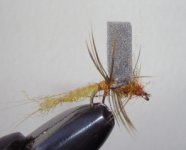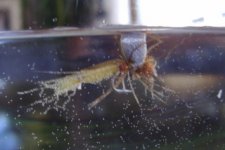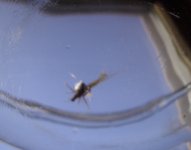F
Fishidiot
Active member
- Joined
- Sep 9, 2006
- Messages
- 9,960
Rather than hijack Paco's current thread on crippled emergers, I thought I'd start another. Here is the pasted continuation from Paco's thread indicating my approach with some additional info and photos.
Being a big fan of closed cell foam I've spent a lot of time over the years trying to design an emerger pattern that satifies me and after dozens of different iterations I still can't seem to nail this fly, esp the smaller midge sizes. I have found that a fly that hangs just under the surface film in a HORIZONTAL plane rather than vertical seems to work best so I usually put the foam midshank. Although midges also emerge from their exo in a horizontal position, I still design my midges to hang vertically. Anyway, frustration aside, here's where I am these days with emergers.
The trouble with foam is getting the right size "ball" or foam clump to float the fly and it seems that the slightest difference in weight will require a different amount of foam, while keeping the foam to a minimum so as to maintain the fly's narrow profile. To deal with this problem, I'll tie several complete emergers with an extended foam post that protrudes up from the hook shank about a quarter inch for a typical #16 sulpher. Once tied, I'll soak the flies and throw 'em in a bowl of water. Each fly's foam post is very carefully cut down in tiny increments until the fly floats just at the surface level. I find you have to do this with each fly rather than trimming all to the same size. Some may be overtrimmed and sink. These flies are immediately discarded to the recycle bin. As you trim down the foam post and drop the fly back in the water, push it under the surface and watch as it floats back up. With some practice, you'll be able to "estimate" the float return rate and when to stop trimming down the post. To be sure, this is a slow and painstaking process but it's worth it has it ensures that every emerger in your box will perform (ie float at the correct level and position) that you expect.
The ultimate goal is to keep the fly's profile narrow and sparse while maintining enough foam to keep it at the surface. Many emergers are tied too thick and bushy in my opinion.
The top photo shows the fly tied with a large post ready for testing.
The second photo shows the fly in a clear glass water bowl with trimmed down foam post. Note that the fly hangs just below the surface tension. This is where you want it.
The third photo shows the floating fly from underneath as a rising trout would see it.
Being a big fan of closed cell foam I've spent a lot of time over the years trying to design an emerger pattern that satifies me and after dozens of different iterations I still can't seem to nail this fly, esp the smaller midge sizes. I have found that a fly that hangs just under the surface film in a HORIZONTAL plane rather than vertical seems to work best so I usually put the foam midshank. Although midges also emerge from their exo in a horizontal position, I still design my midges to hang vertically. Anyway, frustration aside, here's where I am these days with emergers.
The trouble with foam is getting the right size "ball" or foam clump to float the fly and it seems that the slightest difference in weight will require a different amount of foam, while keeping the foam to a minimum so as to maintain the fly's narrow profile. To deal with this problem, I'll tie several complete emergers with an extended foam post that protrudes up from the hook shank about a quarter inch for a typical #16 sulpher. Once tied, I'll soak the flies and throw 'em in a bowl of water. Each fly's foam post is very carefully cut down in tiny increments until the fly floats just at the surface level. I find you have to do this with each fly rather than trimming all to the same size. Some may be overtrimmed and sink. These flies are immediately discarded to the recycle bin. As you trim down the foam post and drop the fly back in the water, push it under the surface and watch as it floats back up. With some practice, you'll be able to "estimate" the float return rate and when to stop trimming down the post. To be sure, this is a slow and painstaking process but it's worth it has it ensures that every emerger in your box will perform (ie float at the correct level and position) that you expect.
The ultimate goal is to keep the fly's profile narrow and sparse while maintining enough foam to keep it at the surface. Many emergers are tied too thick and bushy in my opinion.
The top photo shows the fly tied with a large post ready for testing.
The second photo shows the fly in a clear glass water bowl with trimmed down foam post. Note that the fly hangs just below the surface tension. This is where you want it.
The third photo shows the floating fly from underneath as a rising trout would see it.







